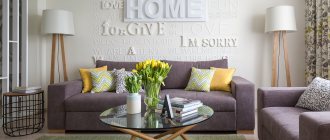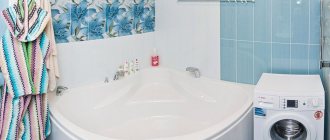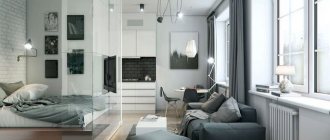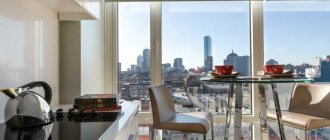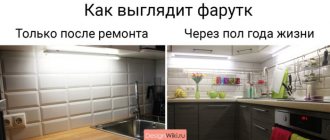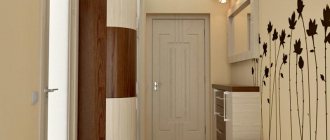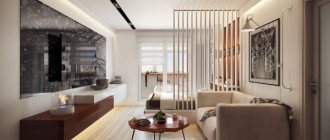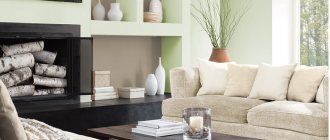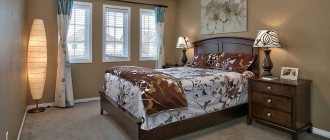The studio apartment has several features, the main one being the absence of walls and partitions between rooms. This type of living space is small in size and low in price, so it is best suited for one person or a small family. The exterior of the studios looks light and spacious even with a small room size. Disadvantages include a limited selection of furniture and styles, as well as poor ventilation.
Rules for decorating a studio apartment with your own hands
When creating a design for a studio, you should adhere to the following rules:
- it is mandatory to have a project with drawings: without it it is extremely difficult to place furniture in a limited space;
- prefer modern interior styles with an emphasis on functionality;
- the dominant shades are light, but not necessarily classic white;
- exclude large elements, be it a large painting or a massive kitchen set;
- the use of glass, metal, and reflective surfaces is encouraged;
- Clear but unobtrusive zoning is required.
At the preliminary stage, it is recommended to draw up a detailed design plan. This will help you think through non-obvious details, evaluate the compatibility of decoration and furniture, and visualize an approximate picture of the finished interior.
How to arrange an apartment?
With proper arrangement of a studio apartment, you can create a truly cozy and comfortable design.
How to furnish the furniture?
Furniture elements should be highly functional and located in appropriate areas. Furniture must be installed so that it does not block passages or impede movement around the room.
The most optimal solution for a studio is transformable structures or, for example, a folding corner sofa and a folding bed. When choosing these models, you should take into account their disassembled size.
It is better to use built-in cabinets as storage systems, which help to significantly save space.
An excellent design move would be to separate the kitchen space from the rest of the room using a bar counter. This piece of furniture not only has a very stylish look, but also represents a comfortable dining area, which can also be equipped with various drawers for utensils and other things.
The photo shows the arrangement of furniture with a bar counter in the interior of a modern studio apartment.
Color spectrum
The studio design looks most harmonious in a light design using calm white, beige, milky, cream and other pastel shades. This way it turns out to visually enlarge the room and give it greater comfort.
For those who prefer decoration in catchy and rich yellow, green colors or choose contrasting black-and-white or red-white combinations, the best solution would be to complement the decor with furniture pieces in discreet colors so that the overall ensemble does not look too colorful.
The photo shows the design of a studio apartment, made in black and white colors.
A design made in a darker color, for example, gray, dark blue, black or brown, is considered quite advantageous. Such an interior has a modern and even slightly futuristic look, but requires addition with warm lighting.
Curtains and other textiles
Curtains from textiles in a studio apartment are often used to delimit the room or decorate the windows. Curtains are a very elegant interior detail that allows you to visually increase the area of your living space and give it a special lightness. For example, the maximum effect can be achieved with the help of light flowing curtains, in the form of weightless tulle or organza.
To add extra height to a room, it is better to use canvases that extend from the ceiling to the floor. Conventional curtains are also replaced with roller blinds, Roman blinds or blinds. When choosing a curtain ensemble, it is important that it be harmoniously combined with other interior items, decoration and furniture.
The photo shows white tulle curtains on the windows in the design of a studio apartment.
Room layout and design choice
Before renovation begins, the studio apartment is divided into several functional zones. The main difficulty of the design is to think through the interior and functionality of each of them separately, while simultaneously combining all areas into a harmonious composition.
Kitchen
The kitchen area is separated from the rest of the space by a partition, furniture, or zoned using finishing. In a studio apartment, a good choice would be built-in and multifunctional appliances: dishwasher, electric oven, multicooker. The space on the walls is not left empty, but is used to place wall cabinets for storing dishes and kitchen utensils.
The dining table and chairs are chosen to be compact. Leave a minimal amount of decor so as not to create a feeling of clutter and disorder in a small space.
Living room
This area is separated by a sofa or a small wardrobe. A TV is placed opposite: it can be hung on the wall or installed on a cabinet or in a wall cabinet. If space allows, place a coffee table and an armchair nearby. On the wall nearby there are hanging shelves for books and various personal items. For small apartments, they often buy a folding sofa - then the living room area is transformed into a bedroom.
Sleeping area
The sleeping area is most often placed in the corner of the studio, hidden behind an additional partition or curtain. A cabinet is placed nearby, and shelving is hung on the walls. In small apartments they use built-in beds that are hidden in the wall during the day. In more spacious studios, the sleeping area is separated by a high podium. Drawers are built inside for compact storage of linen and personal items.
Bathroom
The bathroom in studio apartments is most often small, combined, and rectangular in shape. Compact plumbing is suitable for it: a toilet with an installation system, a built-in sink, a shower corner or a cubicle. The option with a sit-down or corner bath looks good. The dryer and washing machine are placed on top of each other to save space. The remaining part of the bathroom is reserved for shelves, cabinets and other devices for storing personal belongings. Additionally, various hangers and holders are placed on the walls.
Hallway
The entrance area in studios is often small and narrow. It is enough to place the most necessary items in it: a wall mirror, several hooks for outerwear, a shoe stand. If the layout allows, you can install a wardrobe that effectively uses the space near the wall.
Other zones
If a child lives in the apartment, a children's area is needed. Multi-tiered furniture is ideal for her: there is a desk at the bottom and a bed at the top. The ladder along which the child climbs up contains retractable drawers for storing small items. A closet is installed nearby, the upper shelves of which are reserved for clothes and personal items, and the lower shelves for toys.
An adult’s workplace is organized according to a similar scheme. The upper zone is occupied by a bed, the lower zone is a functional zone (painting easel, home recording studio or desktop with a computer). The disadvantage of this option is that it is not suitable for large double beds.
Studio kitchen and bathroom: features
Kitchen
. When arranging this area, you should take into account not only the location features, but also the arrangement of the cooking area.
- Only the essentials
. For two people or one person living in a metropolis, the kitchen is more likely a place for cooking in the evening or on weekends. Therefore, think about what you really need from equipment in the house and purchase the most necessary and compact ones. A tile with 2 elements instead of 4, an elegiac kettle, a microwave, a food processor (it contains a meat grinder, a blender, a vegetable cutter, and so on), a universal frying pan, an electric grill or other equipment. - No bulky furniture
. Instead of cabinet fronts, consider installing open modular shelves. And if some furniture is placed on its end (for example, a high table), then it will become both a functional partition and a bar counter.
As for the bathroom, you cannot do without physical partitions for the sake of hygiene and aesthetics. In this case it will be enough:
- shower cabin instead of bathtub;
- tray for a small top-loading washing machine. By the way, a machine with horizontal loading can be placed in a niche under the sink - this way you can save even more space.
Interior of a small studio apartment
The main emphasis when decorating a small studio is on expanding the space and its economical use. It is worth abandoning any bulky and impractical items.
The decor is mainly used on the wall, so as not to clutter up the limited space. They prefer folding furniture: a transforming sofa, a table with a set of ottoman chairs hidden under it, an ironing board built into the closet, etc.
Studio ideas with a balcony
The design of apartments with a balcony may include placement in this part of the studio:
- work area (workshop or office). A transforming table for sewing or an artist’s easel would look ideal on the balcony;
- dressing room;
- resting places (with audio equipment, TV, table, cozy pillows);
- parts of the kitchen area (meal area).
Advice from an expert
Tatiana Nabokova
Interior designer since 2010. Completed more than 100 design projects for apartments and countryside real estate
Original design of a studio apartment 25 sq.m. m. may also include the arrangement of a single bed on the balcony. The sleeping area is usually separated from the rest of the space by glass sliding doors.
Fashionable style solutions
Simple, minimalistic styles without emphasis on details and decorations are suitable for decorating a studio. All zone-rooms are designed strictly according to one design direction, forming a single harmonious space throughout the apartment.
Loft
In this style, the emphasis is on naturalness and practicality, bordering on rudeness. Bare brick walls with plaster instead of wallpaper, straight, simple forms in the design of furniture and decor, products made from untreated wood and stone are typical features of this design direction. Pipes and wires on the walls, open communications are not a relic of an unsuccessful renovation, but original decorative elements that add originality to the interior. A loft is best suited for a studio with large windows, as dark shades predominate in it.
Scandinavia
Features of the Scandinavian style are light shades, natural materials, and an abundance of natural light. The emphasis is on coziness and comfort, without unnecessary pathos and bulky decor. The shapes and lines of furniture and accessories are simple and clear, but without roughness or sharp corners.
Using this style makes the studio appear brighter and more spacious, so it is best suited for small apartments. Custom-made furniture made from natural materials, decorations made from natural stone and wood, and rare indoor plants will help add originality to the interior.
Modern
Characterized by soft rounded lines, the use of natural materials, the predominance of light colors or their artificial muting. One of the features is the lack of symmetry, which is convenient when dividing the studio into zones. Modernism welcomes the use of glass, metal, chrome and metal surfaces, which helps in expanding a small living space.
High tech
It is distinguished by the use of modern high-tech materials, compact multifunctional furniture, and transformable products. The color scheme is soft, muted, the lines are smooth and rounded. The decor is minimalistic, the accessories serve a practical function. All these features make the style ideal for decorating small spaces, including studio apartments.
Classic
A style that combines simplicity and luxury. It is distinguished by the use of natural materials, a large amount of textiles, small but elaborately shaped furniture and plumbing fixtures. It is quite difficult to create a successful classic interior in a studio apartment. It is recommended to use large prints, shiny or chrome elements, mirrors, wall decorations, and textiles for zoning.
Provence
The main feature is homeliness and comfort. Light colors, light textiles, natural materials, simple rounded shapes and lines, an abundance of useful trinkets and handmade accessories as decorations help achieve this effect. A large window providing natural light will be a good addition and make the apartment even more comfortable.
Minimalism
In this style, the main emphasis is on functionality and a minimum of details. The furniture is small, often folding or pull-out. The decor is minimal. The color scheme is neutral and discreet, bright shades are used only to create accents. Like high-tech, minimalism is most appropriate for decorating a small-sized living space, since it allows you to use limited space as practically and comfortably as possible.
Modern finishing materials
The materials used are classic and modern. The economy option involves paper wallpaper on the walls, linoleum on the floor, whitewash or PVC tiles on the ceiling, paint on the walls, floor, and ceiling of the bathroom. For a premium class or simply a more expensive finish, parquet, boards on the floor, decorative plaster for walls, suspended ceilings, ceramic tiles in the bathroom and toilet are suitable. Less commonly used are natural and artificial stone, brick, and designer 3D wallpaper. Wallpaper with vertical stripes visually pulls the wall up, with horizontal stripes - to the sides.
The materials used for partitions are plasterboard, plywood, clear or frosted glass, fiberboard, and chipboard. Doors are made of MDF, metal, solid wood, window frames are made of metal-plastic or wood. The materials for making furniture are selected according to the chosen style: for the classic style it will be wood, stone, in the high-tech style - metal, glass, minimalism will be made of plastic, MDF.
You should not use small tiles, wallpaper with a lot of patterns, voluminous stucco molding, columns, textured stone - such decoration greatly clutters the territory of the apartment.
Color spectrum
The choice of shades for decorating a studio apartment is quite limited. It is not recommended to use bright, attention-grabbing colors: red, orange, purple. They not only visually narrow the space, but also overload the interior.
Light shades
Classic in small studio apartments - light shades. Popular options include:
- white;
- beige;
- light gray;
- Ivory;
- lactic;
- sand.
You can complement the main color with delicate pastel tones of blue, green, pink. This will prevent the interior from becoming overly gray and boring.
Dark
Such tones are used carefully in small apartments and only in combination with the main light shade. Colors should not be too saturated. Bright versions of dark blue or purple are not suitable - instead you should take muted and smoky ones. Various shades of dark gray look good. In small quantities, burgundy, dark brown, and walnut are appropriate.
Color solutions and lighting in a 23 sq. m studio
To create the desired visual effect of a spacious room, you need to correctly arrange the light and determine the priority colors in the interior.
Color solutions
Using bright colors in the design of small studios will not be the best solution, because such colors make the room smaller. You should choose warm, light, pastel colors; they make the room more spacious.
Expert opinion
Romanova Ksenia Petrovna
Interior design expert and fabric store manager
This applies not only to wallpapering, but also to the choice of curtains and furniture. An excellent design solution would be to use bright colors as accents.
Finish options
Studio decoration is the main tool for zoning and visual expansion of space, so you need to choose it carefully. Preference should be given to strong, durable materials that do not need frequent replacement.
Floor
I most often use laminate to cover the floor: it is inexpensive, easy to install, and can withstand almost any household load. Parquet would also be a good solution: it is most often used to decorate living and bedroom areas, where a feeling of warmth and comfort is important. For the bathroom use tiles or ceramic tiles. Natural materials such as wood and marble are less commonly used. They will create comfort and luxury in a small room.
With the help of floor finishing, a studio is most often zoned. This can be either a combination of several materials, or one coating in several variations - for example, with different patterns or a combination of lighter and darker shades.
Walls
Paint is considered the most successful option for decorating walls in a studio. It is inexpensive, easy to apply and does not take up extra space, unlike tiles, panels and some other materials. Another good solution is classic wallpaper. They are durable, easy to hang, and come in a wide variety of colors and patterns, allowing them to fit into any interior.
The classic option is a combined finish, when 3 near walls are painted, and the far one is covered with wallpaper. With the right choice of colors and patterns, this will not only visually expand the space, but also divide it into zones.
Ceiling
For the studio, choose the white option. This makes the apartment brighter and more spacious. Whitewashing serves as finishing. Sometimes it is supplemented with decorations in the form of artificial beams and stucco molding, but such solutions look good only in attic apartments.
Stretch ceilings with and without built-in lamps are popular.
Design project development
The studio's design project is quite suitable for decorating a small room in a dorm or remodeling a cramped one-room apartment. The living room is combined with the kitchen, and if there is a balcony, with it too. There is only a compact bathroom in a separate room.
Here they provide:
- the most compact, comfortable, ergonomic furniture;
- light, thin zoning elements;
- many mirrors;
- light finish;
- lack of volumetric decor.
In a room with a ceiling height of three or more meters, a second “floor” can be easily organized, where a bedroom, storage space and even an office are located. An insulated balcony is also used for these purposes.
With the help of mirrors, proper lighting, and a monochromatic light design, the space visually expands.
Design techniques that expand space
When drawing up a design, it is worth skillfully using the technique of visually increasing space. Among them:
- large prints;
- patterns in the form of wide lines or stripes along the edges of the walls;
- bright lighting;
- gradients;
- small pieces of furniture and accessories;
- predominance of light shades.
It is important to provide for free space between furniture and appliances. Otherwise, the space will seem cluttered despite any techniques.
https://youtube.com/watch?v=vluVEN2oegI
Lighting
If there is a lack of natural lighting, you should take doubly care of artificial lighting - the abundance of light will visually expand the room. The backlight is chosen local - for each zone, its own, as well as general, adjustable brightness.
In the “sleepy” area, dim diffused light is provided - ceiling lamps, special lampshades, sconces. For the kitchen, contour lighting combined with general ceiling lighting is suitable.
Thick curtains visually reduce the space, so they are replaced with blinds or roller blinds located close to the glass. This will allow you to effectively use the area of the window sills.
The work area should be well lit - enough to fully read, write, and do work on a laptop. If there is a nursery, it should be very light during the day, and before bedtime a night light with a light sensor is turned on.
Examples of correct zoning
A studio apartment should be divided into zones unobtrusively. You should not fence them off from each other with thick partitions or highlight them with bright colors. All areas should be harmoniously combined and smoothly transition into each other, forming a single interior.
Selection and arrangement of furniture
Large pieces of furniture can perform the zoning function. A classic example is a sofa that separates the living room and bedroom or kitchen areas. A good choice would be various cabinets and shelves.
They should not be too high or solid - this will create a feeling of cramped and cluttered. Cabinets with visible shelves, glass elements, etc. are preferred.
An option used abroad for zoning the kitchen and living room is a bar counter. It does not take up much space, looks stylish and is appropriate in any interior. But such a piece of furniture is expensive and not always practical, so a table or several cabinets are often used to delimit the space.
Lighting nuances
It is recommended to install a separate set of lighting fixtures in each area of the studio apartment. This solution has the following advantages:
- expansion of space due to the fact that the room becomes brighter;
- additional zoning;
- convenience - you can turn the lights on and off separately in different work areas without disturbing other residents.
For the bedroom and living room area, warm lighting is preferable, helping to relax and relax. It is better to install cold light lamps in the kitchen and workspace - they promote better concentration and increase productivity.
Partitions and curtains
Curtains, whether textile curtains or frame blinds, are a classic tool for zoning. Light tulle can be used to protect the living room area. Thick curtains with additional sound insulation, such as Japanese or bamboo, are good for a bedroom or work place where peace and quiet are important. Additionally, zones can be delimited by special partitions made of glass or wood, but they are difficult to install and cost more than curtains.
Advantages of small apartments
A compact studio apartment is a special type of layout, where there are practically no partitions or walls. Small housing with proper zoning is common in the megacities of Japan, Europe and America, where every square meter is very expensive. A good design project for a small studio apartment also costs a lot of money. But you can use the recommendations of experts to make several of your “squares” of living space cozy.
A studio apartment is a space planning option that appeared in Russia not so long ago.
The small size of the “studio” is an opportunity for your creative self-expression, where it is easy to emphasize some design concept or vision of aesthetics. This is as functional and economical as possible, especially during the heating season, and also in terms of repair costs.
A few decades ago, few people thought about demolishing all the walls in their apartment and combining the rooms into one space.
A thoughtful design project for a small studio apartment is considered ideal for certain categories of citizens:
- A young couple who have just separated from their parents;
- Students whose wealthy parents prefer to move them away from the negative influence of the hostel;
- Entrepreneurs who are forced to work for two cities for years and often come on business (cheaper than paying for a hotel);
- Creative individuals using the studio as a creative workshop;
- A single resident of a metropolis who wants to have a compact apartment in the center of the capital or a large regional center;
- Lovers of modern housing with an unusual layout;
- Couples living as guests from different cities or countries, having adult children and forced to meet on neutral territory.
Now this option is used very often and apartment owners prefer studios for many reasons.
The absence of stationary partitions and interior walls is a great advantage in terms of functional changes. With the birth of a child, it is easy to transform the interior design of a small studio apartment by adding a children's corner with a play area. As your lifestyle changes, you can expand your workspace to perform additional tasks remotely from home. If you often have guests in the house, it is recommended to “expand” the soft corner with additional seats.
The studio apartment was popular in America and Europe: it was simultaneously used as housing for young people and as a creative workshop.
See alsoApartment design for a young man
Decor and accessories
Decorations in all areas of a one-room studio should be selected in the same style and present a harmonious composition. Appropriate decorations in a small apartment:
- paintings;
- beautiful shelves and other wall installations;
- unusual lamps;
- mirrors;
- small vases, glass or metal figurines;
- items that perform both practical and decorative functions: painted porcelain dishes, colorful towels, holders;
- houseplants.
You should avoid heavy textiles, bulky frames and other bright and large decorations: they will not only take up too much space, but also distract the eye, introducing an imbalance into the interior. Interesting ideas for studio decor can be seen in the photographs below.
Useful tips and recommendations for arrangement
In addition to the external design of the studio, it is worth considering technical aspects. If the apartment will have several types of finishing, you need to determine the joints in advance and measure their length. It is not recommended to combine laminate and tile in any place except for the narrow area near the bathroom door. If you want to add variety to the finishing materials, it is better to opt for parquet.
When dividing an apartment into zones, it is worth considering the location of the windows. Areas close to them will be light, distant areas will be dark even on bright days, so additional lighting is necessary for them. Based on practicality and convenience, the kitchen and living room are placed closer to the window, and the bedroom further away.
Since there are no walls in the studio that prevent the spread of odors and the accumulation of moisture, which leads to mold and musty air. Installing good ventilation and a hood with a valve will help solve the problem.
Peculiarities
When arranging the interior of a studio, it is important to consider several main features:
- The apartment has no partitions; they only separate the bathroom.
- Most studios are 23 sq. m. have a rectangular shape with one window or loggia. With rare exceptions, such rooms are square in shape, however, as practice shows, it is for a studio of 23 square meters that a square is not a very convenient shape.
- Premises without loggias and balconies are most often divided into two zones: a kitchen and a recreation area. If you have additional space, you can attach it to the main one, or make a full-fledged office.
Mistakes in the design of a studio apartment
The most common mistakes when designing a studio:
- an abundance of dark or bright colors;
- use of textured materials;
- heavy textile;
- excess white, lack of color accents;
- bulky furniture;
- overload with small details.
The most common mistake in studio design is problems with zoning - insufficiently expressed or, conversely, too sharp division into areas makes the interior disharmonious. Experience and competent premature planning will help you avoid this.
Choice of colors
Before you start the renovation, choose a design - a project from a photo or create an individual one. This will help determine the costs of upcoming work and help avoid alterations to sockets, partitions, and walls.
The design of the studio should be chosen in light colors. For example, white color, taken as a basis, visually expands the space. Bright accent details will add uniqueness. A contrasting pattern and the same color of curtains on the windows will help give additional height to the ceilings. Examples of successful combinations can be seen in the photos of apartments where renovations have already been done.
You may be interested in: Apartment 28-29 sq.m: design features and the best options for space distribution
